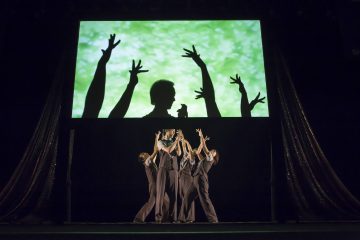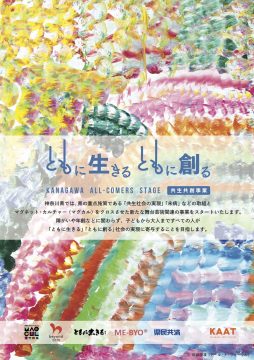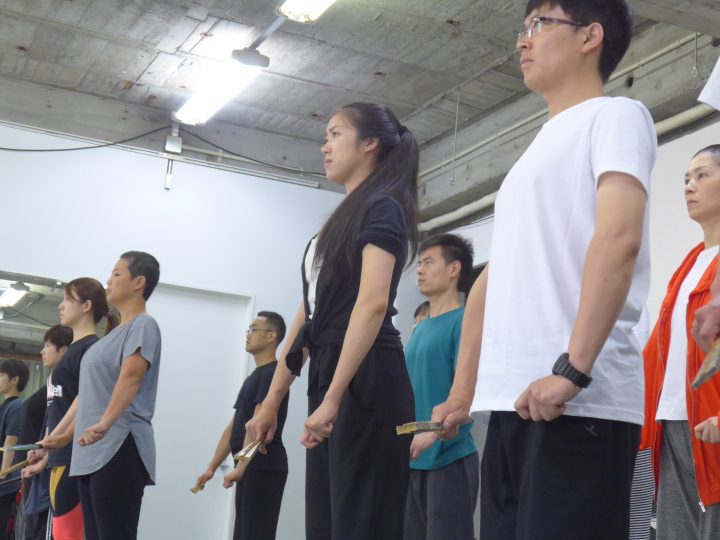Interview with Taku Yamamoto of Hanchu-Yuei

Interview and Text: Kyoko Tokunaga Portrait: Masamasa Nishino
Supported by: International Performing Arts Meeting in Yokohama 2015
There are works that change and grow according to the demands of the environment and the times, apart from the will of the creator. Hanchu-Yuei's medium-length work "Girl X," which was performed at Shinjuku Gankagaro, a small gallery in Shinjuku in 2013, was performed again at TPAM the following year, and was soon invited by Kakiseni , an art support group in Malaysia, where the original work and a co-production with the local team were performed in May. In November, it was invited to Chulalongkorn University in Thailand, where it won two awards, including the Best Screenplay Award, at the Bangkok theatre Festival Awards 2014. This year, at TPAM, it will be performed as a dance piece, an international co-production with Thailand, on February 14th and 15th. We spoke to writer and director Suguru Yamamoto, who created and protects the work, while also absorbing its growth. At the time of the interview, Yamamoto was in Thailand for about three weeks working on the piece, so the interview was conducted over Skype.
The Birth of "Girl X" -- Theater is always talking about the dead --
-- Let's start from the very beginning. The story of "Girl X" has two main threads: a young man who seeks out the perpetrator of a series of rape-murders of young girls and seeks divine punishment, and a young man who uses underhanded methods to rebel against his older sister who has married a doctor and is living a luxurious life.
Yes, that's the story.
── In the past two or three years, Hanchu-Yuei's works have established a style in which actors perform in front of text, photographs, and color blocks projected onto walls or screens using a projector. The actors' movements are sometimes comical, and the text and color blocks are vivid, making the works appear very pop at first glance. Where does the darkness in the content, which is the polar opposite of this, come from?

"Girl X" 2014 / TPAM in Yokohama 2013 / Photo: Hideto Maezawa
あんまり公には言ってないんですけど、これをつくった時は震災(東日本大震災)で参っていたんですね。恐怖感とか、いろいろなネガティブな感情が、今思うとちょっと過剰反応なくらい自分の中にありました。
── However, when you wrote the work, two years had passed since the earthquake.
As time passed, it started to have a stronger effect. It felt like a body blow, with a time lag.
-- Is the time difference the reason why there were no direct stories about "natural threats" or "the deaths of many people" being to blame?
The rule I imposed on myself when I created that work was not to write any words directly related to the earthquake disaster. I thought it would be insensitive for me (who was not affected by the disaster) to use such direct expressions. There is only one place where the word Geiger counter appears, but otherwise it is not used at all. I thought that by imposing such a rule, I could create a certain mood.
What do you mean by a certain mood?
It's the mood of the people that was in me at the time, and around me. "Girl X" doesn't just depict the disaster. The man played by Ohashi-kun (Ohashi Kazuki, an actor affiliated with Hanchu-Yuei) is looking for an enemy with a hammer, but it doesn't matter if you replace the enemy with the government, for example. In other words, it's something that isn't in front of you, but exists on the other side of the TV, or even if you meet it, it's something that feels human and doesn't seem like an enemy... As the man with the hammer is watching TV in front of an electronics store, the news comes on that the perpetrator of the serial rape and murder of young girls has been arrested. At that time, an old man watching TV next to him says, "This guy should be caught and executed quickly." But when you actually meet the perpetrator, you feel, "I can't believe this person would do such a terrible thing." It's all about that.
── This is something I feel is common to your other works, but it seems like you have a strong interest in human malice. What's more, you're not interested in "what is malice?" but rather, "what makes malice possible?"
That's certainly true. I always feel like I want to question the ethics of the audience, including myself. For example, when an incident occurs, people's thoughts about it vary, right? I want to create a device that filters out the audience, that makes them feel that their feelings may be different from those of the person sitting next to them. I may be a bit particular about giving my plays that kind of function.
-- While you write episodes that link to reality with a thrilling sense of distance, you also incorporate the unrealistic perspective of a fetus's monologue.
A baby in the womb has no say, right? So I thought that this has not been written much in plays, and I wanted to bring it out. I have always felt that theater is all about the dead. There are dramas that hint at the existence of unborn lives, but they are not expressed in their words. I am more interested in unborn lives than in stories of the dead.
-- Is it curiosity or ambition as a playwright that makes you want to include words that have hardly been written yet in your plays?
It's both my personal feelings as a playwright and my own feelings about it.
Living things and non-living things - to me, everything is on the same level -
── In Goodbye Japan - I Want to Sleep in Meditation - (2013), you wrote lines for a chair. Is it your natural intuition to treat beings, such as fetuses, that many playwrights do not give much personality to as equals?
I don't see a definitive difference between life and non-life. It's just a matter of whether something is moving or not. So whether it's a chair or an unborn life, I probably paint with the same sensibility as an ordinary human being. The audience may receive something different, but I don't make a distinction between them.
Hanchu-Yuei "Goodbye Japan - I want to sleep in meditation" 2013 / © Hanchu-Yuei
── I remember when I asked you what kind of music you liked, you replied, "I listen to jazz and classical music. I don't dislike J-POP, and I like Western music too." You gave the same answer about movies and novels, and when you were a university student, you were doing theater and also joined a Rakugo club. In other words, for you, you don't have a strong sense that anything is special from the beginning, and everything is of equal value to you?
I think so. They are all really on the same level. I really like gagaku and things like that (laughs).
── Listening to you talk, I wondered if that omnivorous nature is connected to the awareness that "chairs, fetuses, and human beings all have an equal right to have a say."
I really like being called an omnivore. I want to call myself an omnivore guy (laughs). I eat a lot of different things, and I might show what comes out of them - excrement, if you will. But I've never consciously tried to watch or listen to anything in order to create a work. I watch and listen because I like it. That's why I don't really want people to know what I like.
── To use the analogy of excrement, it's like eating meat, vegetables, and fish, and what comes out is plastic. It's like the molecular structure of what you absorb and what comes out are completely different. In the past, your work reflected a more omnivorous feel, but recently the trend you just mentioned has become stronger. I think that's linked to the time when you started using video.
This may seem contradictory to the fact that I'm being interviewed like this now, but with each passing year I become more conscious of not letting anyone know who I am.
── Why do you not want to be found out?
Well, actually, I'm a very small person. What I want to write about is something much bigger, something outside of me.
── Ah, if you use only the food you eat as nutrition, the composition of your work will be equal to yourself.
I don't think I've ever made something like a daily drama before, but when I was a student, I thought I could do it with just my sense. But as my work gradually became more visible to the public and more people came to watch, I started to think that sense alone wasn't enough. I wanted to make something with more strength.
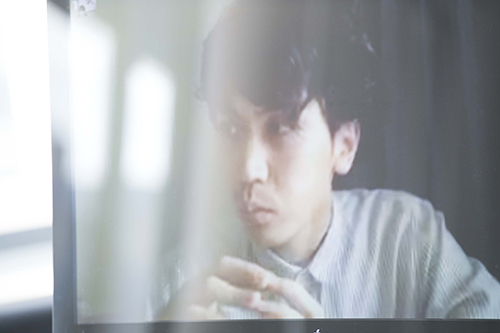
-- Girl X is a work with many strengths, but one of the keys to it is the ending. The young man finally finds his enemy but is unable to bring himself to kill him, so he hits himself repeatedly with the hammer he has, causing his blood to spread all over the place and turn into an ocean. The whole story is projected on the screen as text, but all the characters are in hiragana, so the story suddenly takes on a picture book-like tone and achieves a deeper universality. That is proof of the strong affinity between fiction and non-fiction that you have in your mind.
I have no resistance to that (the difference between fiction and non-fiction). Recently, many people in the theater world - and I'm a theater person myself (laughs) - have a complex about stories, and I feel that the theater world is moving toward structuralism because of this. I like both stories and structures, and I believe in the power of fiction, so if I were to create a scene where someone flies in the sky, I believe that it can be made to work in the story without actually hanging them. I don't think I could have achieved that ending if I hadn't projected the text with a projector. In terms of matching what I wanted to do with the technique, it was an ending that could only have been achieved with "Girl X."
── In this video, the actors do not act against a background of text or photographs, but rather the text and photographs and the actors exist side by side, on an equal footing, influencing each other as opposing elements. When did you first come up with this idea?
I did a piece called "Assassin from Ganymede" (October 2011) in Kyoto, which is actually the essence of Hanchu now. At the time, I tried to have actors move within a video as a story in the world of RPG, but the frustration I felt there led to the next step. I thought I could do this better. When I was doing "Ganymede", I was thinking much more seriously about two-, three-, and four-dimensional things. The relationship and possibilities of flat and solid things. Going back a little, I also thought a lot about having actors move in two dimensions when I did "Hanchu Yuei's Space Adventure 3D" (August 2011), which was done as the opening work for the Ganka Gallery, although there was no video.
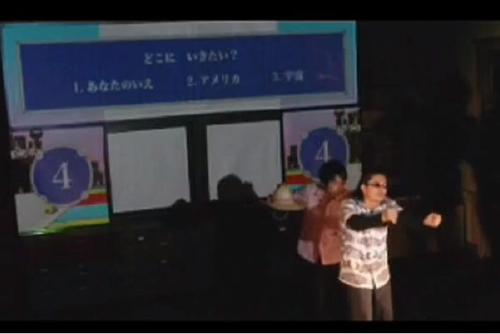
Hanchu-Yuei "Assassin from Ganymede" 2011 / © Hanchu-Yuei
Replacing the story ── Uncovering cultural differences that are disruptive to the story ──
── Now that we've talked about movement (laughs), let's finally talk about the work you'll be performing at TPAM this time. Can we understand it as a dance version of "Girl X," a collaborative work with a Thai company called Democrazy Theatre?
It's a dance piece.
── So a dance piece is a piece that only features dancers?
There will also be actors. The other is Kage, the artistic director and performer of the company B-Floor, which is quite famous in Thailand, and Apom of Democrazy. Kage can dance, but Apom hasn't done much dancing. The performers are these two.
*All names are nicknames. Thai people are given nicknames along with their official names from the time they are born, and these are the main ways they are addressed.

Production scene in Thailand / Photo: Taku Yamamoto
Who will be co-directing the play?
His name is Tam, and he is a choreographer, director, and dancer, and he sometimes writes his own texts. He is about two or three years older than me. He is a very intelligent and well-mannered gentleman, but his ideas, or rather, what he is trying to do, are very outsider.
── How are you and Tam working together now?
The foundation is already complete. If the foundation is like a vessel, then we are now thinking together about what kind of water to put in it.
-- It's a little hard to imagine adapting "Girl X" into a dance piece.
Today marks the third week since I arrived in Thailand, and before I arrived, they had already translated the plays into movement. It wasn't mime, but the act of expressing the words taken from the play with one's body, and from what I saw, that wasn't wrong.
I'm going off topic a bit, but why did Tam want to make "Girl X" into a dance piece this time? It's because he's a dancer, but at the same time, it seems that Thailand is now in a situation where people can't really say what they want to say. It's a problem of censorship. He is conscious of that. In other words, when he chose dance as a medium, he intended to express his intention of "we don't talk," and I was very much in favor of that, so I said, "Let's make a dance piece then." However, if you do that, you gradually lose the need for a story. There was a time when I felt a sense of crisis that there was no point in me being there, and that the text didn't need to be "Girl X," and it was painful.
-- It feels as though Girl X has been swallowed up by their ideology.
Moreover, I couldn't imagine it working. Of course, Tam has his own standards and philosophies, but I didn't understand them at first, and I could only talk about my image of the premiere. Then he said, "But that's not a collaboration." Of course, I also wanted to collaborate, and we had a quiet argument like that for about a week. But one day, he drew a diagram and explained it to me. "Right now, the work is at this stage, and this is what I want to aim for. I understand the elements of the story you mentioned, so I want to make sure that it intertwines well with the structure I'm thinking of." When I saw that, I realized that the story of "Girl X" was not something that was separated or absorbed, but was synchronized with Tam's ideas, and I could see what I should do from there. Now I'm just working towards that goal.
── It seems like you, Mr. Yamamoto, to grasp things visually through blueprints. A specific question: What about projecting text from a projector?
Yes. I also think about the quality of the characters. The name of the place, "Shinjuku Gyoen," appears because it was originally written in Japanese, but Thai actors don't know that. I want to use that difference. Or, by having Thai actors play characters that are like symbols of Japan, I'm trying to bring out layers of culture.
-- It seems that, rather than going against the sense of crisis, collaboration has suddenly deepened.
That's right (laughs). Another thing I'm thinking about is that in Thailand there are something like "12 rules for being Thai." It was decided when the military staged a coup, and there were 12 items like "1. You must respect the king." I'm going to impose something similar on the actors. It's a system that binds identity. If you think of the overall flow as vertical, that's already been done, so what we're thinking about is a horizontal device. As "Girl X" progresses, we'll insert things that come from a place where Thai and Japanese cultures are mixed, such as the Thai perspective, the Thai perspective from me as a Japanese person, and vice versa. I think it's a sideways attack that stops the story, because there should be something that can be seen by it. Also, although it's called a dance piece, it's not really a dance. The choreography is entirely in charge of Tam, but he says he's tired of beautiful dance, and that it's about how to incorporate everyday movements.

── Based on that image, do you think the finished product will be something that can be called "Girl X"?
I think we have to defend that at all costs. At first, we didn't have that vision at all, but now Tam and I are both aiming for that.
